This is a page within the www.staffshomeguard.co.uk website. To see full contents, go to SITE MAP.
GENERAL INFORMATION ON THE HOME GUARD
HOME GUARD TRAINING
RIFLES
by
David G. P. Morse
|
The following
article has been written by David G.
P. Morse of the
Warwickshire Home Guard Living History Group and is reproduced
here with his generous permission.
|
|
HOME
GUARD TRAINING RIFLES
by
David G. P. Morse
|
During the dark
days of May 1940 when Operation Dynamo brought
back some 420,000 British, French and Belgium
soldiers, plans had been announced that a
defensive civilian- based army was to be
raised, kitted out and armed ready to help
defend our shores This was to be called the
L.D.V., Local Defence Volunteers, later to be
called the Home Guard.
The only issue with
this desperate plan was the arming of this new force.
We had left 50% of our weapons and equipment
behind in France with not enough time to
destroy all of it! What were we to do?
The returning soldiers were the first priority
to rearm. We had plenty of rifles, bayonets
and bullets for them although we needed more,
but what about this new arm of the country's
defence?
Well, to start with
the LDV, in a lot of cases, made do with the
Mark I broom handle. This enabled those who
had had no formal training to at least learn
how to march with some resemblance of order!
It would take a
long time for real rifles and then sufficient
ammunition to filter through especially to
those Battalions furthest from the front line
on the South Coast and so individuals,
platoons and then some manufacturers started
making their own versions.
One of the earliest
'imitation' arms was just a length of gas pipe
with a bayonet welded into the end.
Much later, when
rifle shortages persisted, Churchill noticed a
Home Guardsman bearing one of these weapons on
parade. He immediately ordered that large
numbers be manufactured and issued. The only
issue was that it 'was hated' by the Home
Guard: in general it was ungainly, did not
look like a rifle and was ridiculed by one and
all.
When delays were
obvious a cut-out rifle shape was formed out
of a
suitably thick piece of timber, in the case
below out of a scaffolding plank with a thick
metal butt plate to help hold it together. The
overall length was the same as an SMLE and
bayonet. No trigger, magazine receiver or bolt was employed.

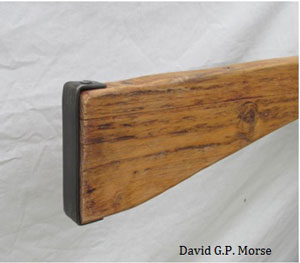
Soon, though, the more
imaginative started making their rifles with
sights made from nails and bits of machinery.
A bolt made from a ... Bolt! A solid bar
barrel and even a butt disc made from a washer
and screw.
Now fitted with a sort of trigger
and magazine it was starting to look like a
rifle.
The one below came from a
Cheshire, UK, Battalion. |
Some went for a
simplistic design, just using a solid round
bar for the barrel, a purpose made magazine,
even though it didn't look like a proper one,
and a heavy duty butt plate.
The next one,
below, was a economy version of the one above
where they have only used a semi-circular
piece of bar for a barrel. No butt plate,
hence the rear end wear and no trigger!
I have seen one other identical to this
one. This one came from Lincolnshire Home
Guard. |
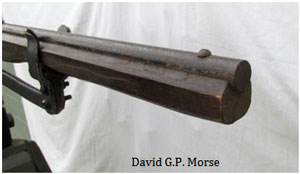 |
This next one is
one of a pair that I have and came from
Tunstall, Staffordshire. They were made by a
company called William Durose who were a
famous prestige wrought iron gate
manufacturer. Whether these were made for the
factory H.G. I don't know as I have not been
able to get a response from what I think is
the present company. The company name is
stamped upon the side. The bolt is missing,
the barrel, though solid, has a shallow hole
drilled in the end. A stylised trigger, a
magazine that looks similar to a real one and
a thick butt plate completes it.
 |
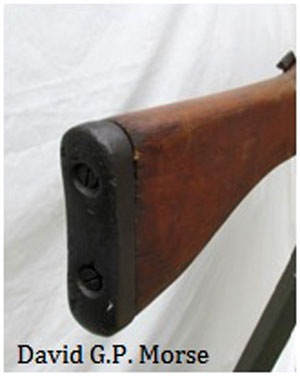 |
Now we
are getting to the point (below) where almost exact
copies of the real thing were being attempted.
It looks like an SMLE but with parts like the
sights and bolt missing.
I have seen one other
that looked like this and it is in the
Imperial War Museum, London. It has a very
heavy duty non-moving trigger, guard and
magazine made out of wood as are the sling
loops! The cast nose has been broken and the
butt plate is of flimsy construction. They
have included a safety catch and so it's
really a commendable attempt. |
|
The reproduction of
British rifles improved when the makers
starting casting original looking bolts and
receivers and sights as can be seen on this
Long Lee below. A wooden magazine was retained
as was a wooden heavy duty trigger! The barrel
made from a solid bar of steel gave it a
similar weight to the original.
The final one in
this selection is in fact a copy of an SMLE
with most of the good points seen in the ones
above. Cast metal receiver, sights, nose cap,
magazine and trigger but with a poor butt
plate. Sling swivels are in evidence. This is
in fact a training rifle from WW1 as issued to
the V.T.C., the Volunteer Training Corps, as
the stamp indicates under the butt. These were
supplied to the V.T.C. for the same reason
that the Home Guard required them: the
training of new recruits and a shortage of
real weapons. Undoubtedly a Home Guard
Battalion somewhere would have been issued
with this type of mass-produced training rifle
from the "war to end all wars"!
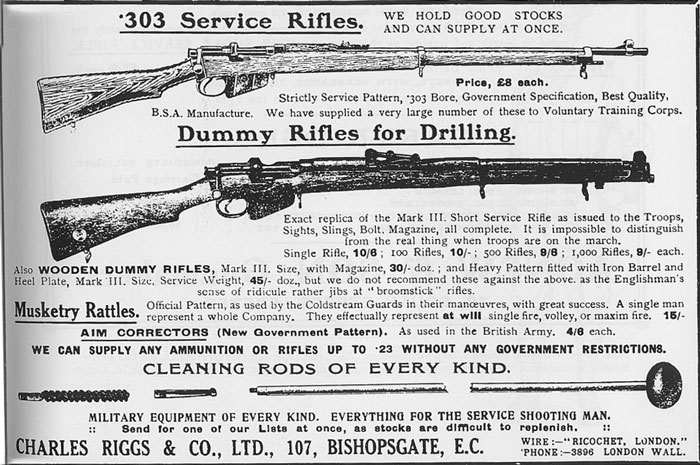
So why
would Home Guard Platoons, Companies
and Battalions go to the trouble of
making replica rifles in the way they
did?
|
From a platoon point of view, morale was improved if you were carrying a rifle even if it was only to make the numbers of "armed" guardsmen greater and even though you had to shout "BANG" when practicing firing! Also the public's morale improved upon seeing most of the platoon training and parading seemingly armed!
The above photo
shows the L.D.V. early in its formation with
only the first couple of rows actually with
rifles. Who knows how many of those were real?
Better to make it look as if all the men had rifles even if
some were replicas.
Also the
advertising poster above says that their
SMLE's cannot be distinguished from the real
thing!
Lastly any
publicity shot that happened to get into the
press and therefore be seen by the Germans
would show a "Well armed civilian force ready
to defend their island from invaders"!
David G.P. Morse
© David G. P.
Morse, December 2016 |
Grateful acknowledgement is made to
the author for his generous permission
for the
publication of the above article within this website.
FURTHER IMAGES OF
TRAINING RIFLES
In use for the training of Women
Auxiliaries......
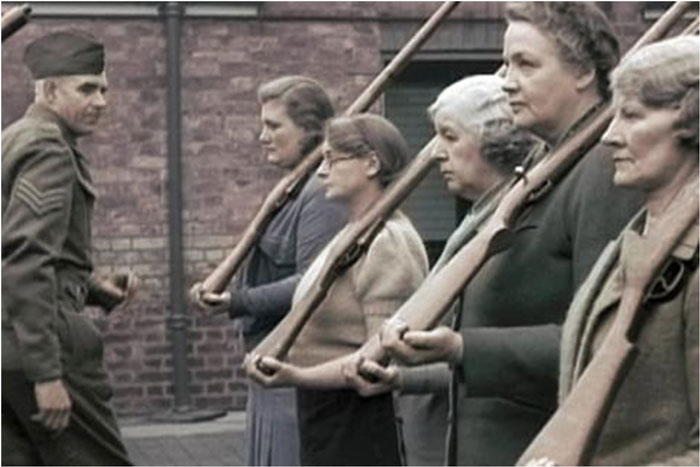
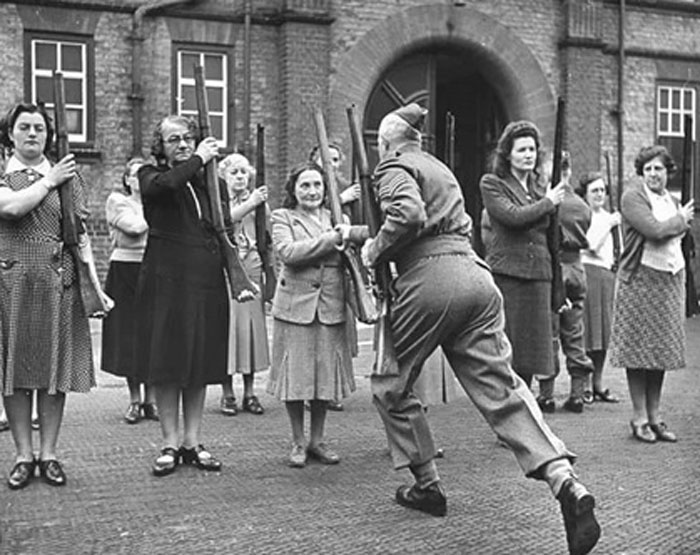
And
some further examples of
miscellaneous
"rifles".....


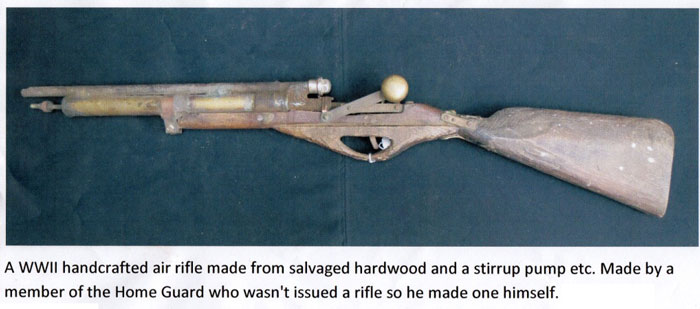
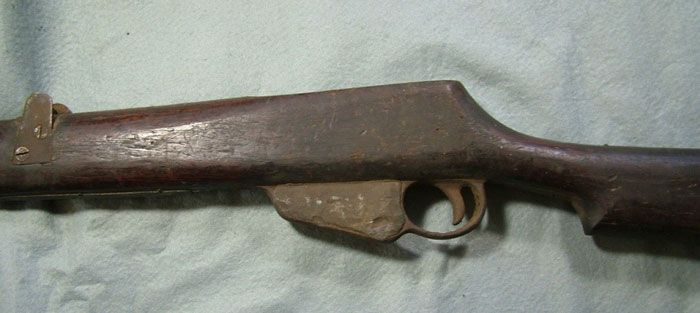 |
Grateful acknowledgement to David G.P. Morse;
and Bernard Cardogan.
Text and all images
annotated "David G.P. Morse" on this
page: © David G. P. Morse
2016
1.
Armourers—Home Guard." Minor repairs and
adjustments " to the following Small Arms :
Rifles', No. 3, pattern 17; Bren" M-.G., Mk 1
.303"; Carbine, T.S.M.G.; Steu, Mk. II; Pistol No.
1, Mk. 6 : —
Sgt. Culbertson, 10 Westmorland
H.G. Sgt. Todhunter, 4 Cumberland H.G. Cpl. Felton, 10
Westmorland H.G. Cpl. Brierjey, 59 Lanes. H.G. Cpl. Pottage,
42 Lanes. H.G. Cpl. Carding, 42 Lanes. H.G. Cpl. Kitchen, 58
Lanes. H.G. L/Cpl. Sinyard, 27 Lanes. H.G. L/Cpl. Porter, 42
Lanes. H.G. Pte. Palmer, 3 Cumberland H.G. Pte. Lavenka, 4
Cumberland H.G. Pte. Graham, 4 Cumberland H.G. Pte. Kearns, 59
Lanes. H.G. Pte. Smith, 38 Cheshire H.G.952. Armourers Courses. " Minor repairs and
adjustments " —
Sgt. S. Mattox, 26 Staffs. H.G.
Sgt. J. Reynolds, 41 Staffs H.G. Cpl. W. Davis, 26 Staffs H.G.
Cpl. B. Kempson, 26 Staffs. H.G. Cpl. A. Fox, 26 Staffs H.G.
L/Cpl. W. Granger, 26 Staffs H.G. Pte. B. Dunn, 20 Staffs H.G.
Pte. H. Tomlinson, 26 Staffs H.G. Pte. J. Yates, 26 Staffs
H.G. § Pte. J. Colstin, 26 Staffs H.G. Pte. F. Morris, 41
Staffs H.Gj 953. Courses ot
Instruction—Armourers' School, Burscough.Course No. 20—2nd May to 9th May,
Sgt. C. Mallalieu, 60 Lanes. H.G.954. Courses of
.Instruction—Armourers. School,Burscou'gh. .Course No. 22—16/5/42 to 23/S/42. , "Minor repairs and adjustments " to the
following Small'Arms and Machine Guns :—Rifles, Lee-Enfield,
Model 17; Rifles, Automatic,. Browning, .300"; Guns M/C Lewis,
Air pattern, ' .300".; Guns. M/C Lewis, ground pattern, .300";
Guns M/C- Browning, .300"; Carbine .M/C" Sten 9mm.'.Mk: II.;
29mm. Spigot Mortar;. Northover Projector and Mountings,
Tripod, Browning, .300" : —" Sgt. C. F. Driver, 57 Lanes. H.G.
Sgt.. E. Lund, 43 Lanes. -H.G..' Sgt. A, A. Ross, 24 Warwick
H.G. Sgt. R. C. Davis, 1 Moil. H.G. , Sgt. J. F. Salt, 22
Ches. H.G. Sgt. D. W. Roberts, 5-Glam. H.G. Sgt. F. C.
Priestman, 92 Lanes. H.G. . • Sgt. G. Thomas, 1 Carrns. H.G. .
Cpl. W. Mack, 9 Worcs. H.G. Cpl. W. R. Kincher, 27 Warwick
H.G. . Cpl. C. Beadnell, 91 Lanes. H.G. Cpl. W. James, 2
Brecknock H.G. L/Cpl. E. Mason, 14 Warwick H.G. L/Cpl. H.
Thomas 1 Pembroke H.G. L/Cpl. S. Gordon, 10 Mon. H.G. Pte. C.
Whittaker, 31 Lanes. H.G.
|
J19 -
December 2016,
updated January 2017
|
|
|